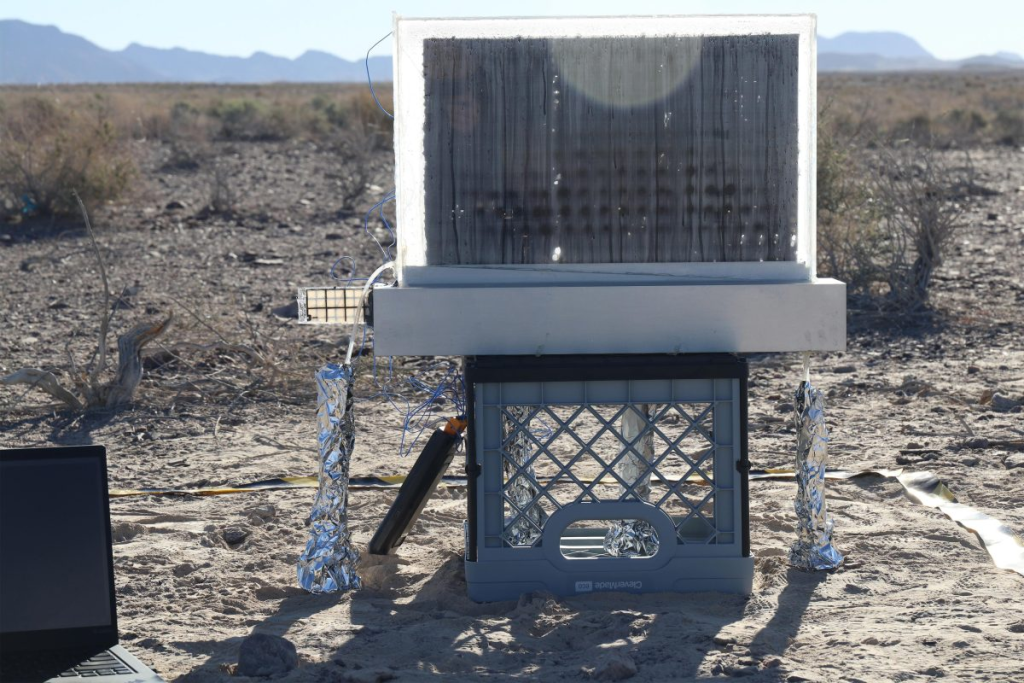Imagine walking across a sun-scorched desert, your throat dry and no water in sight. Now imagine pulling out a lightweight, solar-powered water harvester and drinking clean water drawn directly from the air around you. This once-unthinkable scenario is becoming reality thanks to a new invention from researchers at MIT.
Engineers at the Massachusetts Institute of Technology have developed a Water Harvester that produces drinking water from dry air using nothing but sunlight. Unlike traditional water sources, this compact system doesn’t rely on pipes, electricity, or even high humidity levels. Instead, it quietly and efficiently pulls moisture from the atmosphere, even in desert-like environments.
As the global water crisis worsens due to climate change, population growth, and failing infrastructure, this invention offers a timely solution. It could help hydrate communities with limited resources, support off-grid households, and provide emergency relief after natural disasters. Even better, it operates without burning fossil fuels or requiring electricity.
Let’s explore how this small yet powerful innovation works and why it might reshape the future of water access worldwide.
Turning Air into Water: How It Works
The Water Harvester uses a desiccant material that captures moisture from the air, even when humidity is low. At night, cooler temperatures help the material absorb water vapor. During the day, sunlight warms the device, causing it to release the vapor. That vapor then condenses into liquid, which collects inside a reservoir as clean drinking water.
MIT’s team first used metal-organic frameworks (MOFs), porous materials designed to trap water molecules. While effective, MOFs proved expensive. To improve affordability, the team switched to a gel-based composite that performs similarly at a fraction of the cost.
Because the system relies on passive solar energy and contains no moving parts, it remains energy-efficient, low-maintenance, and dependable. This air-to-water device doesn’t require electricity, making it ideal for remote or resource-limited environments. It’s a prime example of atmospheric water collection done right.
Small Device, Big Results
Despite its modest size, roughly that of a small window air conditioner, the Water Harvester delivers remarkable results. During field tests in Arizona, the system consistently produced at least one liter of clean water per day. Even at relative humidity levels as low as 30 percent, the device kept functioning.

Thanks to its compact design, people can deploy it easily in remote areas, off-grid cabins, refugee camps, or emergency shelters. With multiple units working together, families and larger groups could meet daily hydration needs without needing municipal support.
By extracting water from air, the Water Harvester offers a reliable alternative where conventional sources fall short. It reduces dependence on bottled water, cuts transportation costs, and avoids the challenges of centralized water systems.
Addressing the Global Water Crisis
Over two billion people around the world live without regular access to safe drinking water. Traditional infrastructure projects often require high upfront costs, energy, and maintenance. The Water Harvester offers a simpler path forward.
Read More: No Filter Needed: The Cleanest Drinking Water by Country, Ranked
This device suits a wide range of situations, including drought-stricken regions, rural villages without plumbing, urban neighborhoods facing frequent shortages, and post-disaster zones in urgent need of relief. Since it doesn’t rely on electricity or plumbing, users can deploy it immediately with minimal setup.
In these scenarios, atmospheric water collection provides more than just water. It empowers individuals and communities to manage their own resources with less reliance on failing systems. That autonomy matters, especially in areas where climate change and political instability affect water supply.
Designed for Affordability and Impact
MIT’s engineers designed this technology with scalability and affordability in mind. Their switch from MOFs to a gel-based desiccant helped reduce costs significantly. The goal is to make the Water Harvester accessible to households and organizations in low-income or high-risk areas.
Lower costs also make mass manufacturing more realistic. With the right investment and partnerships, this air-to-water device could become a common feature in off-grid homes, mobile clinics, and field operations across the globe.
By focusing on simple materials and passive energy, the device avoids the financial and logistical barriers that limit most water solutions. It offers both short-term relief and long-term sustainability.
Looking Ahead
MIT’s research team continues to improve the device. They’re working to increase daily water output, boost performance in ultra-dry conditions, and test systems in a variety of climates. There’s also interest in embedding the technology into homes, buildings, or mobile units.
In the future, homes might have built-in atmospheric water collectors built into window frames or rooftop structures. These integrated designs could meet basic drinking needs without relying on central water systems.
As the demand for decentralized solutions grows, the Water Harvester shows that innovation doesn’t always require complexity. Sometimes, the smartest answers come from tapping into what’s already around us.
A New Way Forward
The air around us holds vast amounts of water. Until now, most people couldn’t access it in a meaningful way. MIT’s Water Harvester changes that.
By using solar heat and engineered materials, this device offers a clean, sustainable, and affordable method of extracting water from air. It doesn’t just quench thirst. It creates independence, increases resilience, and opens new possibilities for communities around the world.
Read More: Scientists Discover 2.6 Million Golden Eggs Near Underwater Volcano
